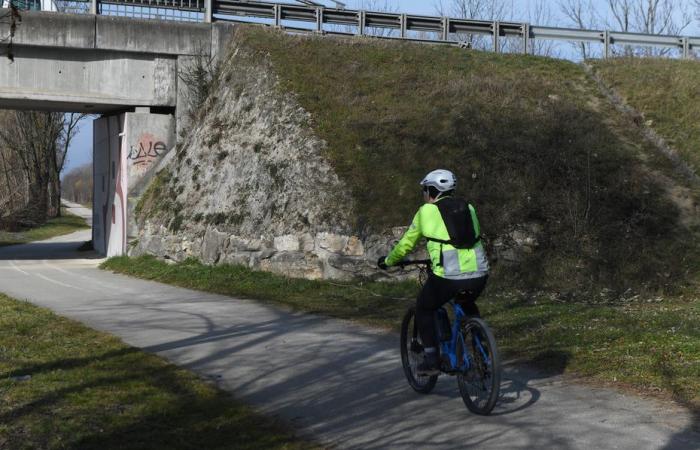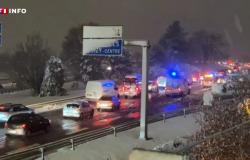Bugs have been regularly deposited, point upwards, on the cycle path between Obernai and Goxwiller (Bas-Rhin) for several months. Openly malicious acts towards cyclists, a sign of growing tension between road users.
Company
From daily life to major issues, discover the subjects that make up local society, such as justice, education, health and family.
France Télévisions uses your email address to send you the “Society” newsletter. You can unsubscribe at any time via the link at the bottom of this newsletter. Our privacy policy
Since July, cyclists and walkers have seen their walks plagued by the presence of bedbugs, points upwards, deposited along the cycle path between Obernai and Goxwiller, in Bas-Rhin. These objects are the cause of many punctures. According to Latest News from Alsace, a resident of Gertwiller was fooled several times during the week of November 6. “Who is bothered by cyclists to the point of carrying out these malicious acts?“, asks the victim in the local newspaper.
His question is all the more relevant as this is not an isolated case. In June and July 2023, a real epidemic of punctures affected cyclists in the Bruche valley, in Bas-Rhin. Hundreds of bedbugs were found on the Wolxheim cycle path. “They had been scattered over several kilometerstraces Adrien Kiffel, the mayor of the town. So it was clearly a thoughtful gesture, in my opinion done on a bike to be able to escape in case the person was spotted.“
Since then, the perpetrator has returned to the ranks and cyclists can once again travel without untimely punctures. But the mayor of the town remains with an impression of insurmountable helplessness when the episode is mentioned to him. “There was nothing to do. We made all the necessary reports to the gendarmerie, but they themselves told us that unless we catch the perpetrator in the act, it is impossible to find him.“
Similar malicious acts have often been committed in rural areas. Is it also because these are less frequented areas? In 2020, one or more people began to scatter bedbugs and install barbed wire along a greenway in Mayenne, for several months. The departmental council had even considered investing in video surveillance cameras for a time, before changing its mind due to the cost.
Much more publicized, acts of sabotage and malevolence towards mountain bikers, in the wilderness, are also legion: cables stretched between two trees in this commune in the Vosges massif in March, or a board of nails carefully hidden on a trail. mountain biking in Aisne at the end of 2023.
These are therefore systematically places that are little frequented, except by occasional cyclists or walkers. Who are those who engage in such acts, and what are their motivations?
It is difficult to establish a precise profile, because those responsible are very rarely identified. But Vincent Kaufmann, director of the urban sociology laboratory at the University of Lausanne, has studied all anti-cycling behavior in depth. According to him, there is a real “feeling of hatred” towards cyclists among part of the population. “Faced with the development of multimodal practices, that is to say people who travel one day by car then the next day by bicycle for example, we notice a handful of diehards who swear only by the automobile. They have the feeling that the development of roads and transport policies are not going in their direction. And for these people the bicycle has become a synonym for being green, which arouses a feeling of hatred.”
Even if nothing says that the Obernai bug installer is an inveterate anti-cyclist, it is undeniable that most of the acts cited above were committed on paths exclusively dedicated to cyclists. Cycle paths and greenways fully represent this new development of public space, potentially perceived as disadvantageous for motorists.
Perhaps those who drive public policies need to be careful not to move too quickly
Vincent Kaufmann, sociologist
The sociologist Rachel Aldred also expressed herself along these lines in an article in the Guardian (article in English) in 2015 already, when she characterized the perception of the bicycle by some: “Previously a means of transport for those who had no choice, it is today seen as the vehicle of those who have the choice and who afford the luxury – that of living in places adapted to the practice and whose the density allows you to get to work at a reasonable distance.“
So should we now take out the pins and barbed wire to express our dissatisfaction with an urban development direction? And, on the other hand, simply deplore the existence of “morons” or “criminals”, like local elected officials, after each of these acts of malevolence? Vincent Kaufmann, author of a column in Le Monde on this subject, pleads for a new “fraternity” between road users. “Perhaps those who lead public policies must be careful not to move too quickly, to take the entire population with them. It is urgent to appease, we saw this a few weeks ago in Paris Even if it is not comparable to bedbugs, of course, there is behind this perception that we have of the cyclist…“
Tuesday October 15, Paul Varry, a 27-year-old cyclist, was crushed to death by a motorist after a violent altercation, triggering a real social debate on tensions between cyclists and motorists.






